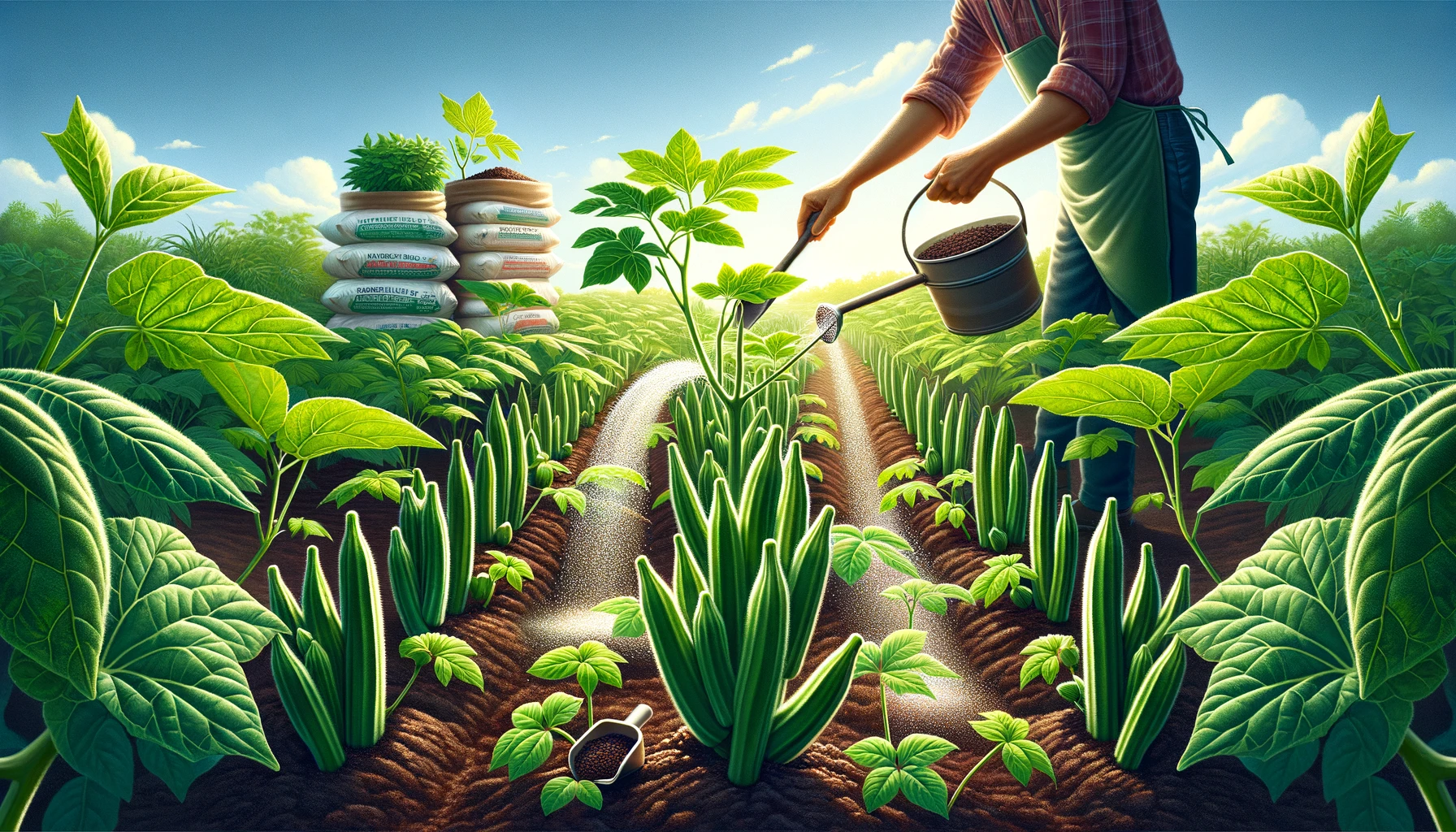Okra (Abelmoschus esculentus) is a warm-season vegetable known for its edible seed pods, which are used in various cuisines worldwide. Proper fertilization is crucial to ensure healthy growth, robust yields, and high-quality pods. This comprehensive guide will walk you through the process of fertilizing okra plants at each growth stage, from planting to harvesting. By understanding the specific needs of okra during its various stages of growth, you can optimize your fertilization practices to achieve the best results.
Table of Contents
- Understanding Okra Plant Growth Stages
- Preparing the Soil Before Planting
- Fertilizing During Planting
- Fertilizing During Seedling Stage
- Fertilizing During Vegetative Growth
- Fertilizing During Flowering and Pod Formation
- Fertilizing During Pod Development
- Organic vs. Chemical Fertilizers
- Common Fertilization Mistakes to Avoid
- Frequently Asked Questions (FAQs)
Here’s a table summarizing the NPK ratios and other key nutrients for various organic fertilizers commonly used in gardening:
| FERTILIZER | NUTRIENTS | BENEFITS |
|---|---|---|
| Compost | NPK: 1-1-1, Balanced nutrients | Improves soil structure, increases microbial activity, enhances water retention |
| Manure | NPK: Varies (e.g., 0.5-0.2-0.4), Balanced nutrients | Adds organic matter, provides slow-release nutrients, improves soil aeration |
| Bone Meal | NPK: 4-12-0, High in phosphorus | Promotes root development, enhances flowering |
| Blood Meal | NPK: 12-0-0, High in nitrogen | Promotes lush growth, helps compost decomposition |
| Fish Emulsion | NPK: 5-2-2, Rich in micronutrients | Fast-acting, boosts plant growth |
| Seaweed Extract | NPK: 1-0-4, Trace minerals, growth hormones | Improves stress tolerance, enhances root development |
| Green Manure | NPK: Varies (e.g., 2-1-2), Nitrogen (legumes), organic matter | Adds organic matter, suppresses weeds, fixes nitrogen |
| Worm Castings | NPK: 1-0-0, Beneficial microbes | Enhances soil structure, provides slow-release nutrients |
| Alfalfa Meal | NPK: 3-1-2, Growth hormones | Promotes soil microbial activity, improves plant vigor |
| Cottonseed Meal | NPK: 6-2-1, Balanced nutrients | Acidifies soil, provides slow-release nutrients, improves soil texture |
| Bat Guano | NPK: 10-3-1, High in nitrogen | Promotes vigorous growth, rich in beneficial microbes |
| Feather Meal | NPK: 12-0-0, High in nitrogen | Slow-release fertilizer, promotes lush foliage |
| Neem Cake | NPK: 5-1-2, Balanced nutrients | Acts as a pesticide, enhances soil fertility, improves plant health |
| Kelp Meal | NPK: 1-0-2, Trace minerals | Promotes strong root development, enhances stress resistance |
| Coffee Grounds | NPK: 2-0.3-0.2, Nitrogen | Improves soil structure, attracts beneficial microorganisms |
| Molasses | NPK: 1-0-5, Energy source for microbes | Improves soil structure, enhances nutrient uptake |
| Rock Phosphate | NPK: 0-3-0, High in phosphorus | Promotes root growth, enhances flowering and fruiting |
| Wood Ash | NPK: 0-1-3, Potassium, calcium | Raises soil pH, provides potassium, contains trace elements |
| Epsom Salt | NPK: 0-0-0, Magnesium sulfate | Improves chlorophyll production, enhances nutrient uptake |
| Banana Peel Fertilizer | NPK: 0-3-42 (approximate), Potassium | Promotes strong root growth, enhances flowering and fruiting |
| Mustard Cake | NPK: 4-1-1, Balanced nutrients | Enhances soil fertility, promotes healthy plant growth |
| Eggshell Fertilizer | NPK: 1.2-0.4-0.1 (approximate), Calcium | Improves soil structure, reduces soil acidity, strengthens plant cell walls |
This table provides a quick reference to the NPK ratios and additional nutrients each fertilizer contributes, helping gardeners choose the right organic amendments for their plants’ specific needs. Adjusting quantities and application methods based on soil tests and plant responses ensures optimal growth and health benefits. For better and detailed information visit our Organic Fertilizers page.
Stages of Growth for Okra Plant
| Growth Stage | Duration | Key Signs |
|---|---|---|
| Planting | 1-2 weeks | – Seeds are planted in prepared soil. |
| Seedling | 2-4 weeks | – Seedlings emerge and develop true leaves. |
| Vegetative Growth | 1-2 months | – Rapid growth of leaves and stems. |
| Flowering and Pod Formation | 1-2 months | – Flowers appear and pods begin to form. |
| Pod Development | 2-3 months | – Pods develop and mature. |
| Harvesting | 3-4 months | – Pods are mature and ready for harvest. |
Section 1: Understanding Okra Plant Growth Stages
Before diving into the specifics of fertilizing, it’s important to understand the main growth stages of okra plants:
- Planting: Planting seeds in well-prepared soil.
- Seedling: The stage where seedlings develop true leaves.
- Vegetative Growth: Rapid growth phase where the plant develops leaves and stems.
- Flowering and Pod Formation: The plant produces flowers and sets pods.
- Pod Development: Pods grow and mature.
- Harvesting: The final stage when pods are mature and ready for harvest.
Section 2: Preparing the Soil Before Planting
Importance of Soil Preparation:
Preparing the soil is essential for providing a nutrient-rich environment for okra plants. The right soil conditions can enhance growth and yield.
Best Soil Types for Okra:
- Well-drained loamy or sandy soil
- Rich in organic matter
- pH between 6.0 and 7.0
Recommended Soil Amendments:
- Compost: Adds organic matter and improves soil structure.
- Well-rotted manure: Provides essential nutrients like nitrogen, phosphorus, and potassium.
- Bone meal: Rich in phosphorus, which is crucial for root and pod development.
Initial Fertilization:
- Mix compost and well-rotted manure into the soil at a rate of 2-3 kg per square meter.
- Add bone meal at a rate of 1 kg per square meter.
Section 3: Fertilizing During Planting
Choosing the Right Fertilizer:
- Organic Fertilizers: Use a balanced organic fertilizer like a 5-5-5 NPK ratio. Apply compost for this purpose.
Application Method:
- Dig planting holes or trenches about 1 inch deep.
- Place seeds in the holes.
- Sprinkle a small amount of balanced organic fertilizer in the planting hole.
- Cover the seeds with soil and water thoroughly.
Section 4: Fertilizing During Seedling Stage
Nutrient Needs:
- During the seedling stage, okra plants require a moderate amount of nutrients to support the development of true leaves.
Types of Fertilizers to Use:
- Liquid Seaweed Extract: Provides a range of micronutrients and growth hormones.
- Fish Emulsion: Rich in nitrogen and other essential nutrients.
Application Methods and Frequency:
- Dilute liquid seaweed extract or fish emulsion according to the manufacturer’s instructions.
- Apply every 2-3 weeks by watering the base of the seedlings.
Section 5: Fertilizing During Vegetative Growth
Nutrient Requirements:
- During vegetative growth, okra plants need higher nitrogen levels to support leaf and stem development.
Recommended Fertilizers:
- Composted Chicken Manure: High in nitrogen.
- Alfalfa Meal: Rich in nitrogen and other nutrients.
Application Techniques:
- Side-dress the plants with composted chicken manure at a rate of 1-2 kg per square meter.
- Alternatively, mix alfalfa meal into the topsoil around the plants.
- Apply every 3-4 weeks during the vegetative growth stage.
Section 6: Fertilizing During Flowering and Pod Formation
Changes in Nutrient Needs:
- During the flowering and pod formation stage, okra plants need more phosphorus and potassium to support flower and pod development.
Best Fertilization Practices:
Application Methods:
- Apply bone meal around the base of the plants at a rate of 1-2 kg per square meter.
- Supplement with wood ash for potassium.
- Apply every 4-6 weeks until the pods start developing.
Section 7: Fertilizing During Pod Development
Preparing Plants for Harvest:
- In the final stages before harvesting, focus on potassium to improve pod size and quality.
Final Fertilization Tips:
- Use wood ash or a high-potassium organic fertilizer.
- Apply a light dressing of compost to maintain soil health.
- Water thoroughly after fertilizing.
Section 8: Organic vs. Chemical Fertilizers
Pros and Cons of Organic Fertilizers:
- Pros: Improve soil health, safe for the environment, and provide slow-release nutrients.
- Cons: May require larger quantities and can be slower to show results.
Recommendations for Okra Plants:
- Organic fertilizers are generally preferred for okra due to their long-term soil health benefits and safety for human consumption.
Section 9: Common Fertilization Mistakes to Avoid
- Over-fertilization: Can lead to nutrient imbalances and plant stress.
- Under-fertilization: Results in poor growth and low yields.
- Incorrect Fertilizer Type: Using the wrong type of fertilizer can harm the plants.
- Improper Timing: Fertilizing at the wrong stage can reduce effectiveness.
Section 10: Frequently Asked Questions (FAQs)
Q: Can I grow okra in containers?
A: Yes, okra can be grown in containers. Ensure the container is large enough and has good drainage.
Q: How often should I water okra plants?
A: Water okra plants regularly, keeping the soil evenly moist but not waterlogged.
Q: What are the signs of nutrient deficiency in okra plants?
A: Yellowing leaves, stunted growth, and poor pod development can indicate nutrient deficiencies.
Q: Can I use chemical fertilizers on okra?
A: While chemical fertilizers can be used, organic fertilizers are preferred for their soil health benefits.
Q: How do I store harvested okra?
A: Store harvested okra in a cool, dark, and well-ventilated place.
For more questions and answers visit this page.
Conclusion
Okra plants are a versatile crop with specific fertilization needs at each growth stage. By following the guidelines in this article, you can ensure healthy growth and high yields. Proper fertilization, combined with good soil preparation and regular care, will help you achieve the best results in your okra cultivation.
Call to Action
Have you tried growing okra? Share your experiences in the comments below! Don’t forget to subscribe to our blog for more gardening tips and articles.



